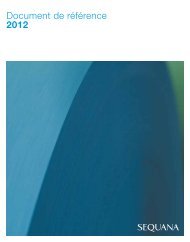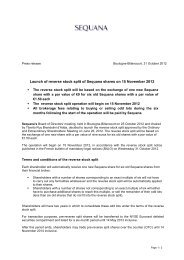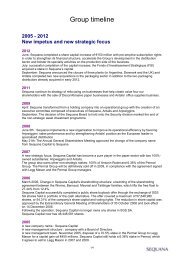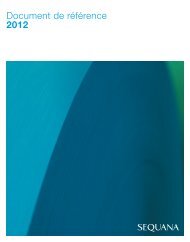Contents
Registration document PDF - Sequana
Registration document PDF - Sequana
You also want an ePaper? Increase the reach of your titles
YUMPU automatically turns print PDFs into web optimized ePapers that Google loves.
Financial position – resultsNotes to the consolidated financial statements 4Foreign exchange riskThe Group’s foreign exchange risk arises on (i) inter-companyfinancing transactions between the Antalis and Arjowigginsgroups and their subsidiaries, and (ii) commercial transactionscarried out by subsidiaries in foreign currencies. It hedges thisrisk through the use of currency options and forward currencycontracts.The foreign exchange impacts of these derivatives should be offsetby gains or losses in the income statement. The exposure onfinancing transactions between the groups and their subsidiariesis relatively limited.As regards operating activities, Antalis’ exposure to foreignexchange risk concerns subsidiaries outside of the eurozonewhose trade receivables and payables may not be denominated intheir domestic currencies, especially subsidiaries in Asia, SouthAfrica and certain Central European countries which set up theirown currency hedges.The Antalis holding company is only exposed to foreign exchangerisk on the management fees it bills to its subsidiaries which ithedges by selling currency forward. The principal exposureshedged for the holding company are positions in the followingcombinations of currencies: EUR/GBP, EUR/USD, EUR/CZK,EUR/PLN, EUR/ZAR, USD/ZAR. Antalis does not use hedgeaccounting to measure its positions and all changes in fair valueare recognised in profit or loss.Arjowiggins’ exposure to foreign exchange risk mainly ariseson the paper pulp purchases (usually billed in US dollars) andexports of the European subsidiaries. The main currency combinationsconcerned are EUR/USD and EUR/GBP for subsidiariesin the eurozone, and GBP/USD for the UK subsidiaries. TheArjowiggins holding company sets up hedges on behalf of thesubsidiaries when they place orders.In addition, in the last quarter of 2012, Arjowiggins sold forwarda portion of the 2013 forecast sales of the operational subsidiaries,as it had done in 2011. It uses hedge accounting to measurethese instruments.The main components (> €1 million) in the Group’s portfolio of exchange rate derivatives at end-2012, consisting of forward purchaseand sales and European currency options (puts and calls) are presented in the following table:TypeCurrency soldCurrencypurchasedNominal amount(in millions of currency units)MaximummaturityFair valuethrough equityFair valuethrough profitor lossTotalfair valueForward EUR USD 29.7 USD 30/09/2013 0.5 (0.9) (0.4)Forward EUR GBP 7.5 GBP 28/02/2013 – – –Forward USD GBP 17.8 GBP 28/06/2013 0.2 0.1 0.3Options ZAR USD 2.5 USD 15/03/2013 – – –Options USD ZAR 42.9 ZAR 15/03/2013 – (0.1) (0.1)Forward ZAR USD 9.2 USD 15/05/2013 – (0.1) (0.1)Forward ZAR EUR 5.6 EUR 15/04/2013 – – –Forward MYR USD 1.8 USD 19/04/2013 – – –Forward CNY USD 1.4 USD 19/04/2013 – – –Options PLN EUR 5.5 EUR 30/01/2013 – – –Forward PLN EUR 16.8 EUR 31/01/2013 – – –Forward CZK EUR 5.5 EUR 30/01/2013 – – –Options CZK EUR 1.1 EUR 19/02/2013 – – –Forward EUR CHF 15.3 CHF 07/01/2013 – – –Forward DKK EUR 4.0 EUR 31/01/2013 – – –Forward SEK EUR 1.9 EUR 31/01/2013 – – –TOTAL (IN € MILLIONS) 0.7 (1.0) (0.3)At 31 December 2012, the total fair value of these hedges was a negative€0.3 million, recognised in profit or loss in a negative amountof €1.0 million and in equity in a positive amount of €0.7 million.A negative amount of €1.7 million was recycled from equity toprofit or loss during the period in relation to currency hedges.Foreign currency sensitivity analysisForeign currency sensitivity analyses at 31 December 2012 focusedon fluctuations in EUR/GBP, EUR/USD, and GBP/USD rates,as these are the currency combinations in which the Group hassold forward a portion of 2013 sales. The Group’s exposure tofluctuations in other currency combinations was deemed too dispersedto be broken down.For the purposes of the analyses, all other variables, particularlyinterest rates, are deemed to remain constant.Sequana | 2012 Document de référence (English version) | 139









